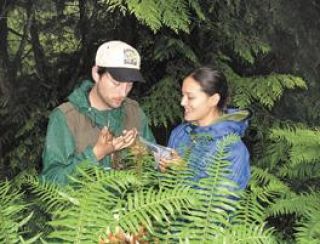LINK: http://www.fish.washington.edu/naturemapping/pierce_county.html
By Dennis Box and Shawn Skager
The Courier-Herald
An overnight campaign to count the wildlife and plants in the lower White River kicked off Friday afternoon and ended Saturday afternoon at the Marion Grange in Buckley.
The Pierce County Biodiversity Alliance and Puyallup River Watershed Council joined forces in the event known as a “bioblitz.” It was the second event of its kind to take place in the state. The first survey was last year in Gig Harbor.
The area surveyed, known as the lower White River, spanned from Buckley to Auburn's Game Farm Park.
According to Linda Burgess, chair for the Watershed Council, the first bioblitz was in Central Park in New York and the idea has spread across the country.
About 80 scientists from this state and around the country, along with residents and volunteers, participated in the survey.
Burgess said the lower White River area was chosen due to the diversity of habitat and variety of species.
The program was designed to count and confirm animal and plant species in the area, to involve residents and volunteers in biodiversity conservation and share the collected information with landowners to assist in managing land while preserving the habitat.
“I thought it went really well,” Burgess said after the event. “I think everyone learned how diverse this area is and how much wildlife is there. It's amazing how this habitat attracts wildlife.”
Although most of the species cataloged were those expected to inhabit the area, a few surprise species were found.
Dr. Gary Shugart, the collection manager for the Slater Museum of Natural History at the University of Puget Sound, attended the blitz to lend a hand - or ear - counting the avian species.
Shugart said he was pleasantly surprised by the diversity of the area's feathered wildlife.
“Practically the moment I got there I was surprised,” Shugart said. “I opened the door on the car and the first bird I hear I said, ‘what is that?'”
Shugart said he went through his mental catalog of bird calls, “which can sometimes take awhile,” before identifying the bird, a rare species to this area called a lazuli bunting.
“It's very habitat specific and is usually found on the prairies,” he said.
Shugart said his team also discovered two colonies of bank swallows, another species rare to this area.
“The first one we found by the gravel pit, and then a second up past the bridge,” he said.
Shugart explained that the bank swallows burrow in groups into river banks, sometimes more than 100 birds per colony.
He added that he knew of only 10 other accounts of the birds in Washington.
“When we first saw them we were a bit amazed,” Shugart said.
Burgess said there were 1,500 individual sightings logged with 596 different species identified, including 96 varieties of birds, 78 types of mammals, eight different bats, 10 varieties of ants, 29 types of moths and butterflies, 32 trees, 51 shrubs and 187 types of grasses and forbs.
The teams met heavy rains on Friday, but the weather cleared on Saturday.
“We had a lot of people out for the open house at the Marion Grange,” Burgess said. “I'm looking forward meeting with the different communities to help create a plan to manage the biodiversity of the area.”
The information collected from a biobiltz survey can be accessed by going to The Courier-Herald Web site at www.courierherald.com and navigate to the bioblitz story.
Dennis Box can be reached at dbox@courierherald.com. Shawn Skager can be reached at sskager@courierherald.com.


